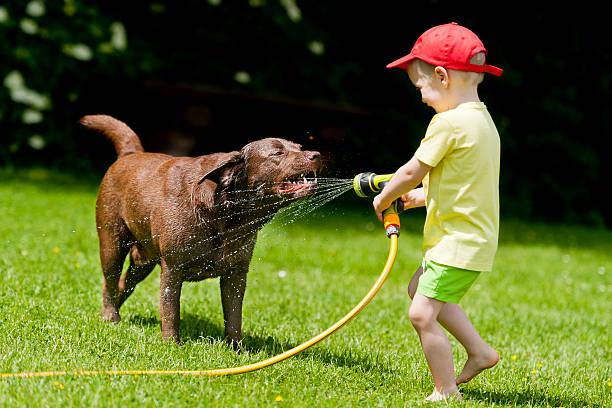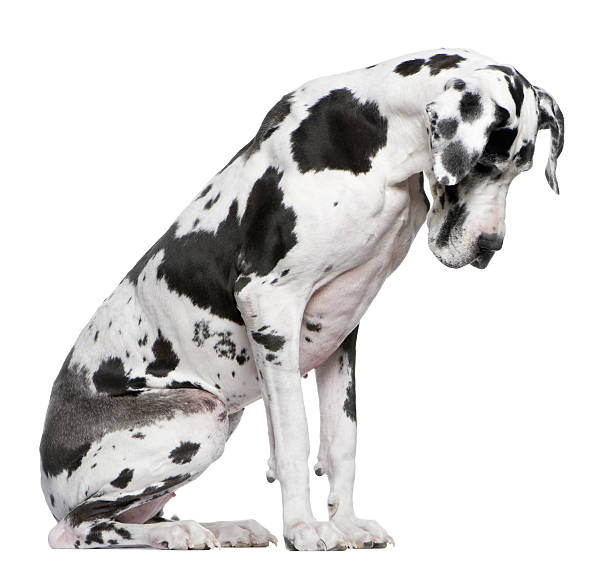It can be very concerning when you notice your once energetic and happy dog is walking slowly with their Head down. This posture change likely signals that something is off.
Determining the root cause is crucial for getting your four-legged friend proper treatment and restoring their health and mobility. Read on for an in-depth look at 15 common explanations for Why Your Dog Is Walking Slowly With Their Head Down.
Table of Contents
You May Also Like to Read: WHY BEAGLES ARE THE WORST DOGS?
1. Pure Physical Exhaustion

One of the most apparent and benign reasons your adult or senior dog may begin ambling with their head down is simply fatigue after too much exertion. Highly active playtime at the dog park, an extra long walk or hike, or even intensive training like agility or flyball can quickly sap your pup’s energy reserves.
As their muscles tire and their respiratory and cardiovascular systems struggle to keep up with demand, your dog will likely start lagging behind you, dragging their feet, slowing to a stop, and dropping their head closer to the ground. Their tongue may hang out as they pant heavily. The fatigue likely causes muscles to relax and the head to naturally lower.
This is your dog’s way of signaling complete exhaustion. Their body is tapped out and needs rest. At this stage, they are unwilling or unable to hold their head up with their usual happy, alert expression. Their top priority is conserving whatever energy they have left to make it home.
In most cases, giving your tired dog adequate time to recharge with rest and sleep will restore their typical enthusiastic posture and brisk walking or running pace. Pups tend to bounce back quickly. But suppose the profound fatigue and head-down slow walking persist beyond a day or so of rest. In that case, a veterinary visit is warranted to ensure your dog is not suffering from an underlying condition.
2. Mental Exhaustion
Just as physical overexertion can weary your dog’s body, excessive mental stimulation can drain them psychologically. Dogs already prone to anxiety may be especially vulnerable to mental exhaustion.
Participating in busy outdoor events with crowds, unfamiliar loud noises, new smells, or children chasing after them can overtax your pup’s mind. If your pup is more reserved, the same goes for introducing too many new tasks in a training session or even intense playtime with highly energetic dogs.
A mentally exhausted dog often displays similar signs to physical tiredness – lagging on walks, stopping frequently, and lowering their head. But you may also notice more tentative behavior, nervous lip licking, yawning, dilated pupils, disengagement, and irritability if they feel pressured by strangers or other dogs approaching.
Just like physical exhaustion, the remedy involves giving your dog adequate downtime to decompress and relax. Keeping them in a controlled, comfortable environment for a day or two helps stabilize their emotions and energy. But seek veterinary advice if anxiety persists. Medication and positive counterconditioning may be needed. This may be the reason Your Dog Is Walking Slowly With Their Head Down.
3. Overheating may be the reason the dog is walking slowly.

Overheating may be the reason.
- Heavy panting
- Rapid pulse
- Thick saliva
- Lethargy
- Loss of coordination
- Vomiting
- Diarrhea
One of the most telling initial indicators of overheating is when your typically bouncy dog begins walking slowly with their head down on a hot day. The head lowering is thought to be an innate protective mechanism to shield the brain and neck area from the sun’s intense rays. Their pace slows dramatically, so minimize exertion that could drive their temperature up further to dangerous levels.
If you notice these changes on a hot day, get your dog indoors immediately and contact your vet. Lowering their temperature quickly is crucial to prevent organ damage and a life-threatening crisis. Place cool, damp rags around their neck, paws, and armpits or immerse them in tepid (not ice-cold) water. Offer small sips of water if they can swallow. Fanning your dog will also gradually lower their core temperature. But seek emergency vet assistance if heat stroke is suspected.
Prevention is also vital. Avoid intense exercise on sweltering days. Ensure your dog has shaded rest areas and fresh water. Older dogs and brachycephalic breeds like bulldogs with shorter snouts overheat more readily and require extra caution. Never leave dogs unattended in vehicles on warm days when interior temperatures can skyrocket and kill them within minutes.
By swiftly cooling an overheated dog and taking preventive measures, you can help them avoid this life-threatening scenario.
4. Muscle Soreness is one reason your Dog Is Walking Slowly
While a reasonable amount of daily activity keeps your dog’s muscles conditioned, too much repetitive motion or improperly warming up beforehand can leave their body sore, stiff, and tender. Activities like agility training, frisbee catching, or hard turns during fetch put extra strain on muscles supporting joints.
Your dog may wake up the day after an overly strenuous workout slowed down and walking gingerly with their head hanging a bit. Shoulder, hip, knee, ankle, and neck joints will all feel the effects of muscle overuse and teardown. Lowering their head helps alleviate discomfort as they ambulate.
Rest days between high-impact exercise sessions give your dog’s taxed muscles time to recover and repair micro-tears. Using supplements like chondroitin and glucosamine may also help relieve temporary soreness. Icing tender areas and massaging gently can bring relief too.
If pain and stiffness persist for more than 2-3 days, though, see your vet. They can prescribe anti-inflammatory or pain medications and recommend rehabilitative exercises to rebuild muscle strength and flexibility. A few days of enforced rest may be in order. In the future, build up activity gradually and include “cooldown” walks and stretches.
5. Arthritis is one of reason your Dog Is Walking Slowly
The most common source of chronic mobility issues and head lowering in aging dogs is a degenerative joint disease, osteoarthritis or arthritis. This progressive inflammatory condition attacks the cartilage cushions within joints.
As the cartilage erodes, the bones begin grinding directly against each other. This causes significant pain and stiffness, particularly after lying still. The joints most often impacted include hips, knees, elbows, shoulders, and the intervertebral joints along the spinal column.
Dogs with arthritis often shiver, limp, lag, and saunter with their head down due to the consistent ache and effort required to ambulate gently. The lowered head position helps take pressure off the inflamed neck vertebrae and painful shoulders. They take tentative steps and pause frequently, usually unwilling to lift their heads.
While arthritis cannot be cured, various treatments can dramatically improve your arthritic dog’s comfort and mobility. Glucosamine, NSAID or opiate pain relievers, joint fluid modifiers, physical therapy, weight management, orthopedic beds, ramps, and massage enable dogs to remain active longer. But progression may eventually necessitate surgery for total joint replacement. Work closely with your vet to optimize your quality of life.
You Might Also Like: CAN DOGS EAT CUSTARD?
6. Injuries is one reason your Dog Is Walking Slowly
Like arthritis, injuries affecting bones, joints, tendons, nerves, or soft tissue anywhere in your dog’s body can significantly alter their gait and head carriage. Common examples include:
- Broken bones
- Dislocated, torn or ruptured ligaments/tendons
- Intervertebral disc disease
- Patella luxation
- Hip dysplasia
- Tendinitis
- Strains or sprains
- Footpad lacerations
An affected dog lowers its head below its natural horizontal alignment to avoid stretching or bearing weight through injured areas. They gingerly walk at a snail’s pace to minimize discomfort and risk of aggravating damage. Brief sniffing and frequent sitting or lying down provide breaks.
Depending on the severity of the injury, rest and medication may resolve acute issues. But surgery, casts, orthotics, and physical rehabilitation are often necessary, especially with broken bones, cruciate tears, spinal disc herniations, and other complex conditions requiring stabilization. Strict confinement and activity restrictions are essential to proper healing, too.
Never try to “push through” lameness or encourage high activity levels. Doing so can cause permanent compensation issues later. Instead, crate rest injured dogs until the vet evaluates them. Supporting proper healing now prevents chronic health problems down the road.
7. Nausea or Digestive Upset
While we don’t fully understand the exact physiology behind it, dogs innately tend to drop their heads when feeling nauseous. There are several theories behind this instinctive posture change:
- It helps realign the gastrointestinal tract to slow digestion
- It minimizes uncomfortable sloshing of stomach contents
- It protects the throat and airway if vomiting occurs
- It utilizes gravity to keep food down and reduce queasiness
Motion sickness is a classic trigger of nausea and the corresponding head-down stance. The rocking sensations disturb the inner ear and equilibrium, inducing nausea. But many other conditions cause stomach distress too, like:
- Dietary indiscretion or food allergies
- Parasites
- Pancreatitis
- Inflammatory bowel disease
- Gastroenteritis
- Intestinal obstructions
- Liver or kidney disease
A dog struggling with nausea will also exhibit other signs like drooling, lip licking, gulping, flatulence, and poor appetite. They may sniff or lick at the ground as if trying to find relief. If your dog cannot keep food down, vomiting or diarrhea may accompany nausea or develop.
If nausea persists for more than 24 hours, take your dog to the vet for anti-nausea medications and fluids and to diagnose the underlying issue. Also, withhold food temporarily, but ensure they stay hydrated with small, frequent water servings.
8. Boredom on Walks is one reason your Dog Is Walking Slowly
While it may not seem an apparent reason, boredom on neighborhood strolls can make your dog seem to amble with its head down. A dog lacking mental stimulation and environmental enrichment sleepwalks through their daily walk, moping along disinterestedly without any pep in their step. Their lowered head and tail signal a “ho-hum” disengaged attitude.
Why the bored behavior? Consider that the average suburban or urban walk offers little novelty or variety for your dog. Walking the same neighborhood route day after day, surrounded by identical houses, trees, fences, and streets, quickly becomes mundane. Their mind ceases to be occupied and engaged.
You can often revive enthusiasm by changing the route, letting your dog sniff and explore more, hiding treats to hunt for, bringing novel toys along, and visiting new parks. Puzzle toys and food-dispensing chew toys provide mental exercise too. Interacting with other dogs, they encounter also breaks up the monotony. Just be sure boredom isn’t masking depression requiring medication.
9. Sadness and Depression reason your Dog Is Walking Slowly
Prolonged sadness and depression can develop in dogs due to significant changes in their home environment and lifestyle. Examples include:
- Death of a human or canine companion
- Divorce resulting in alone time when formerly the constant company
- Children leaving home
- Adoption by a new family
- Moving homes
- Boarding at a kennel
- A new baby in the home
- Addition of other pets
Dogs are susceptible to shifts in their “normal.” Depressed dogs will often isolate themselves, sleep excessively, lose interest in play and walks, and walk slowly with their head and tail down. They seem down and disengaged.
Ruling out medical causes, the remedy involves restoring enrichment and stability. If needed, more quality time with cherished humans, consistent daily routines, and medications all help dogs adjust to change. Some temporarily act out, too, needing additional training and patience. But sadness exceeding two weeks merits veterinary advice.
10. Anxiety may be the reasons Your Dog Is Walking Slowly
Anxiety disorders and phobias can develop in dogs due to genetics, lack of early socialization, trauma associated with a frightening experience, or sensitivities to stimuli like noises, strangers, handling, or environments. Nervous dogs may stroll with their head lowered, scanning for potential threats when outdoors.
Triggers depend on the dog. Leash reactivity focuses on passing people or dogs on walks. Storm phobia involves fear of thunder, winds, shadows, and barometric pressure changes. Separation anxiety surfaces upon humans leave dogs alone at home. Fireworks, motorcycles, thunder, crowds, or construction racket set off noise phobia.
These anxiety manifestations often escalate without treatment. Panicked dogs may flatten themselves on the ground, freeze in place, whine, bark, growl, flail on the leash, or attempt escape. Counterconditioning training and anti-anxiety medications can reduce fear responses. But acute anxiety requires immediate veterinary handling.
You May Also Like to Read: CAN DOGS EAT BABYBEL CHEESE?
11. Dehydration is one reason your Dog Is Walking Slowly
Hydration is critical for your dog’s circulation, organ function, body temperature regulation, waste removal, and electrolyte balance. When a dog becomes significantly dehydrated, they often begin walking more slowly with their head lowered closer to the ground. Why?
In this posture, less energy is expended by ambulating. Dropping their head also helps prevent overheating. Dogs intuitively conserve their resources when lacking sufficient hydration.
Causes of dehydration include:
- Insufficient daily water intake
- Excessive panting
- Profuse diarrhea or vomiting
- Kidney or liver disease inhibiting nutrient absorption
- Diabetes resulting in frequent urination
- Heat stroke
- Vigorous exercise without water breaks
- Teething puppies mouthing and chewing toys
To help rehydrate a dehydrated dog, give frequent small sips of water, unflavored Pedialyte, or low-sodium broth. Seek immediate veterinary treatment for severe lethargy, dry gums, sunken eyes, weak pulse, fever, or any signs of shock. Intravenous and subcutaneous fluids may be necessary. Prevent dehydration by ensuring fresh water access at all times.
12. Anemia is one reason your Dog Is Walking Slowly
Anemia is a reduction in red blood cells or hemoglobin that impairs oxygen delivery throughout the body. There are several forms:
- Hemolytic anemia – Red blood cells are destroyed prematurely
- Bone marrow disease – Production of blood cells is suppressed
- Blood loss anemia – Significant loss of blood from injury or parasites
- Immune-mediated anemia – Antibodies attack red blood cells
The resulting lower oxygen levels induce compensatory reactions like accelerated breathing, heart rate, and altered posture. Your dog may sit or stand with elbows splayed to maximize lung expansion and improve airflow. Their head lowers to position the airway for easier breathing.
During activities like walking, these shortness of breath signs continue. Pale gums, weakness, and exercise intolerance indicate an urgent need for diagnosis and interventions to boost red cell production, like supplements, steroids, or blood transfusions in acute cases. Underlying diseases causing anemia, like cancer or kidney failure, may also require treatment.
13. Respiratory Distress is one reason your Dog Is Walking Slowly
Any condition impeding your dog’s airways or reducing lung capacity will quickly manifest in their posture, especially during exercise. Dogs suffering from respiratory distress tend to move slower with their head extended out rather than lifting upward. Why?
Moving their head forward in a “nose out” position optimizes air intake. The elongated neck and open mouth allow fuller expansion of the throat and chest. Dogs also keep their body lower to ground level to spare the additional effort of erecting their head and body. They pause periodically to catch their breath before plodding forward.
Potential causes of breathing struggles include:
- Laryngeal paralysis
- Respiratory infections
- Chronic bronchitis
- Pulmonary fibrosis
- Pneumonia
- Heart disease or heart failure
- Anemia
- Fluid accumulation around the lungs
- Obesity
- Respiratory foreign bodies like grass seeds
Labored breathing warrants prompt veterinary attention. Your vet will pinpoint the culprit condition through chest x-rays, ultrasounds, bloodwork, ECG, and other diagnostics before prescribing appropriate treatment and management strategies to optimize breathing capacity. Never ignore respiratory changes, as many conditions are progressive when left undiagnosed and untreated.
14. Neurological Disease is the reason your Dog Is Walking Slowly
Any damage affecting the nervous system can disrupt normal coordination, gait, posture, and head positioning. Neurological diseases often cause dogs to walk stiffly and unsteadily with their head lowered. Common examples include:
- Intervertebral disc disease (IVDD) – Spinal cord trauma from bulging or ruptured discs.
- Vestibular syndrome – Inner ear disorder causing loss of balance.
- Wobbler’s syndrome – Cervical spinal cord compression.
- Diskospondylitis – Infection of intervertebral discs.
- Distemper – Viral infection that attacks the nervous system.
- Cognitive dysfunction – Canine version of Alzheimer’s causing confusion and mobility changes.
- Brain tumors or strokes – Intracranial masses or bleeding induces deficits.
- Degenerative myelopathy – Progressive spinal cord damage seen in older large breeds.
- Tick paralysis – Toxin from tick bites induces ascending paralysis.
- Myasthenia gravis – Autoimmune disorder impairing neuromuscular transmission.
- Multiple sclerosis – Nerve damage from autoimmune attack on myelin sheaths.
Any sudden onset of neurological signs like altered gait, weakness, incoordination, seizures, circling, head tilt, or collapse warrants immediate veterinary evaluation. Some conditions like IVDD require rapid surgery to prevent permanent impairment or paralysis if spinal cord compression exists. Other diseases may respond to medications and physical rehabilitation. But early diagnosis and treatment provide the best odds of recovery.
15. Inner Ear Infections is one reason your Dog Is Walking Slowly
The balanced equilibrium needed to walk upright and move the eyes properly relies on intact inner ear anatomy and function. When infections, tumors, trauma, hypothyroidism, or immune conditions damage structures like the vestibule or cochlea, it disturbs their critical role in spatial awareness.
A dog with a vestibular disorder will tilt their head and often walk with a drunken, wobbly gait. They lean abnormally to one side and may move in circles due to the distorted signals their injured ear conveys about position and motion. Moving slowly with their head down is one coping maneuver to control disorientation from mixed signals between their ears.
While some inner ear conditions resolve independently, medications to reduce fluid accumulation, nausea, and inflammation may be necessary, along with exercise restrictions. Surgery is sometimes required for tumor removal or other.
Tips for Improving Your Dog’s Posture and Mobility
If your dog is walking slowly with their head down, try these tips after seeking veterinary advice:
- Give joint supplements to support bone and muscle health. Glucosamine, chondroitin, and omega-3s can help.
- Ask about prescription pain or anti-inflammatory medications to improve comfort if arthritis or injury causes issues.
- Practice a gentle range of motion and stretching exercises prescribed by your vet or canine physiotherapist.
- Help your dog swim or do other non-weight-bearing exercises to stay limber.
- Use a harness rather than a collar, which can aggravate neck conditions.
- Consider orthopedic beds, ramps, raised feeders, and grip-enhanced floors to make their environment more mobility friendly.
- Maintain a healthy lean weight to avoid extra strain on joints and muscles.
- Provide mental stimulation toys and activities to prevent boredom and keep their mind engaged.
Key Takeaways on your Dog Is Walking Slowly
- A lowered head signals something is wrong – don’t ignore changes in your dog’s carriage and gait.
- Look out for related symptoms like vomiting, diarrhea, weakness, or breathing issues.
- Dogs lower their heads to conserve energy, minimize pain and nausea, aid breathing, and steady themselves when unbalanced or fatigued.
- Have your vet examine your dog promptly to diagnose the underlying problem, especially with sudden mobility changes.
- With treatment of the underlying condition, most dogs can regain their normal posture and enthusiasm for activity.
- Prevent issues like arthritis and overheating with proactive joint care, hydration, weight control, and activity moderation.
Conclusion: Why Your Dog Is Walking Slowly With Their Head Down
Changes in your formerly active dog, now strolling with its head down, should not be dismissed as “getting old.” While that plays a role, lowered head posture almost always indicates an underlying problem causing pain, nausea, anxiety, or lack of equilibrium. Be sure to have your dog assessed. Treating arthritis, injuries, ear infections, nausea, and neurological disorders helps restore normal posture and gait. Your dog’s pep and bright-eyed enthusiasm will return once your compassionate vet appropriately diagnoses and manages the root problem. With some TLC and targeted treatment, your dog will be back to chasing squirrels and playing fetch in no time!
FAQs: Why your Dog Is Walking Slowly
How long should I wait to see if my dog’s head-down posture improves?
Don’t wait more than 1-2 days. Seek prompt veterinary advice as soon as you observe changes in gait or head carriage, as delaying treatment for injuries, infections, or other problems can allow them to worsen.
Could my dog’s lowered head signal a life-threatening issue?
Potentially, yes. Rapid vet assessment is crucial to diagnose and treat severe conditions like heat stroke, respiratory distress, poisoning, blood loss, trauma, organ failure, and masses putting pressure on the brain or spinal cord. Don’t risk waiting if your dog exhibits extreme lethargy, collapse, or distress.
Is it normal for a puppy to walk with their head down sometimes?
It’s common for puppies to occasionally trip or lower their heads when tired. But any sustained change in posture or mobility in a growing pup warrants a vet visit to check for injury, pain, illness, or neurological problems that could impair development.
Why does my dog only lower their head indoors?
It may need to be more evident when exploring outdoors. Head lowering due to arthritis, ear issues, or spinal pain may worsen in slippery homes. Have your vet examine your dog for musculoskeletal issues or neurological conditions like vestibular syndrome or Wobbler’s syndrome.
What are the most common health reasons a senior dog lowers their head?
In older dogs, the lowered head posture typically stems from arthritis, intervertebral disc disease, dementia, vision loss, nausea, neurologic issues like vestibular disease, or muscle atrophy. Schedule a senior vet visit to identify any age-related diseases needing medication or treatment.
Please let me know if any article parts need additional expansion or detail! I’m happy to add more content to ensure it thoroughly addresses the topic.







